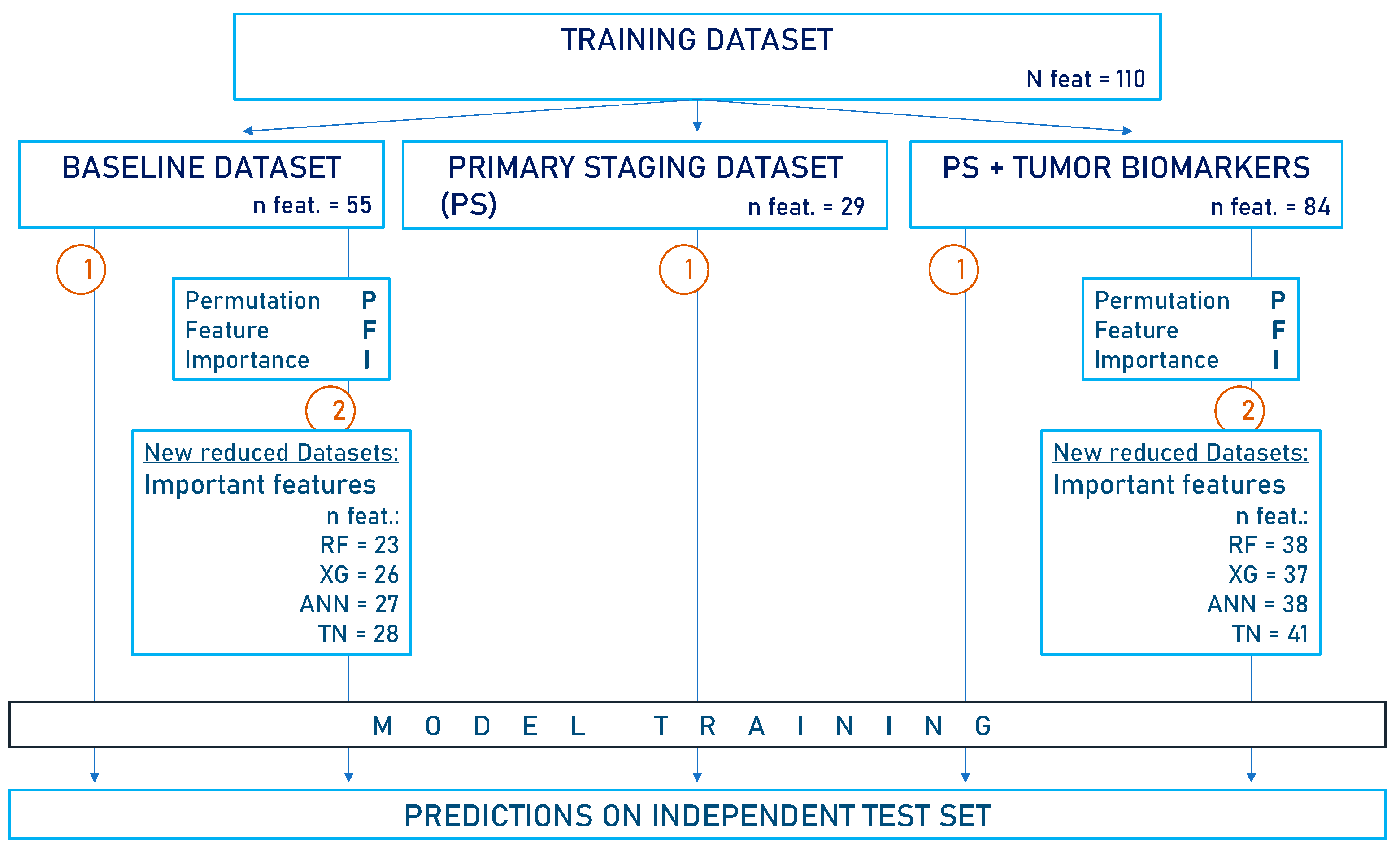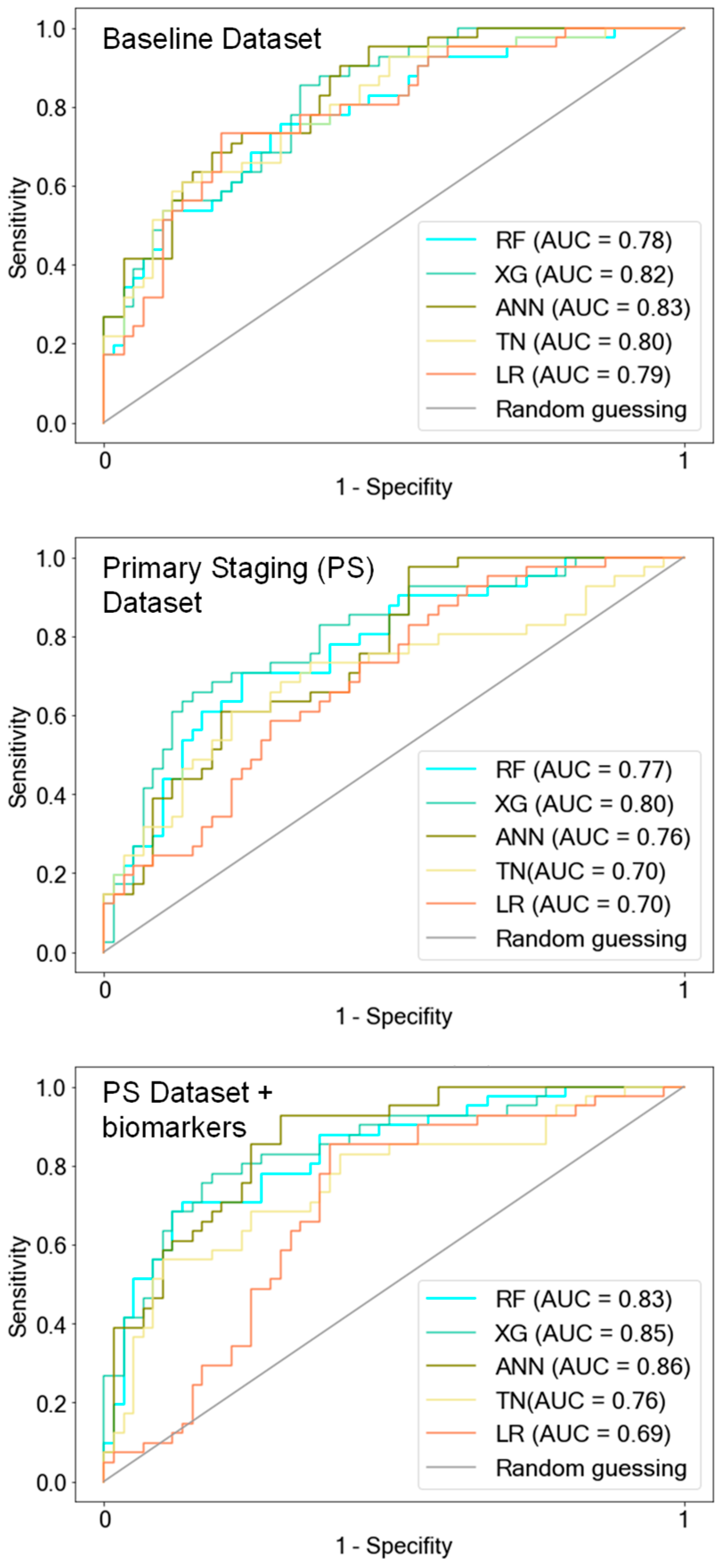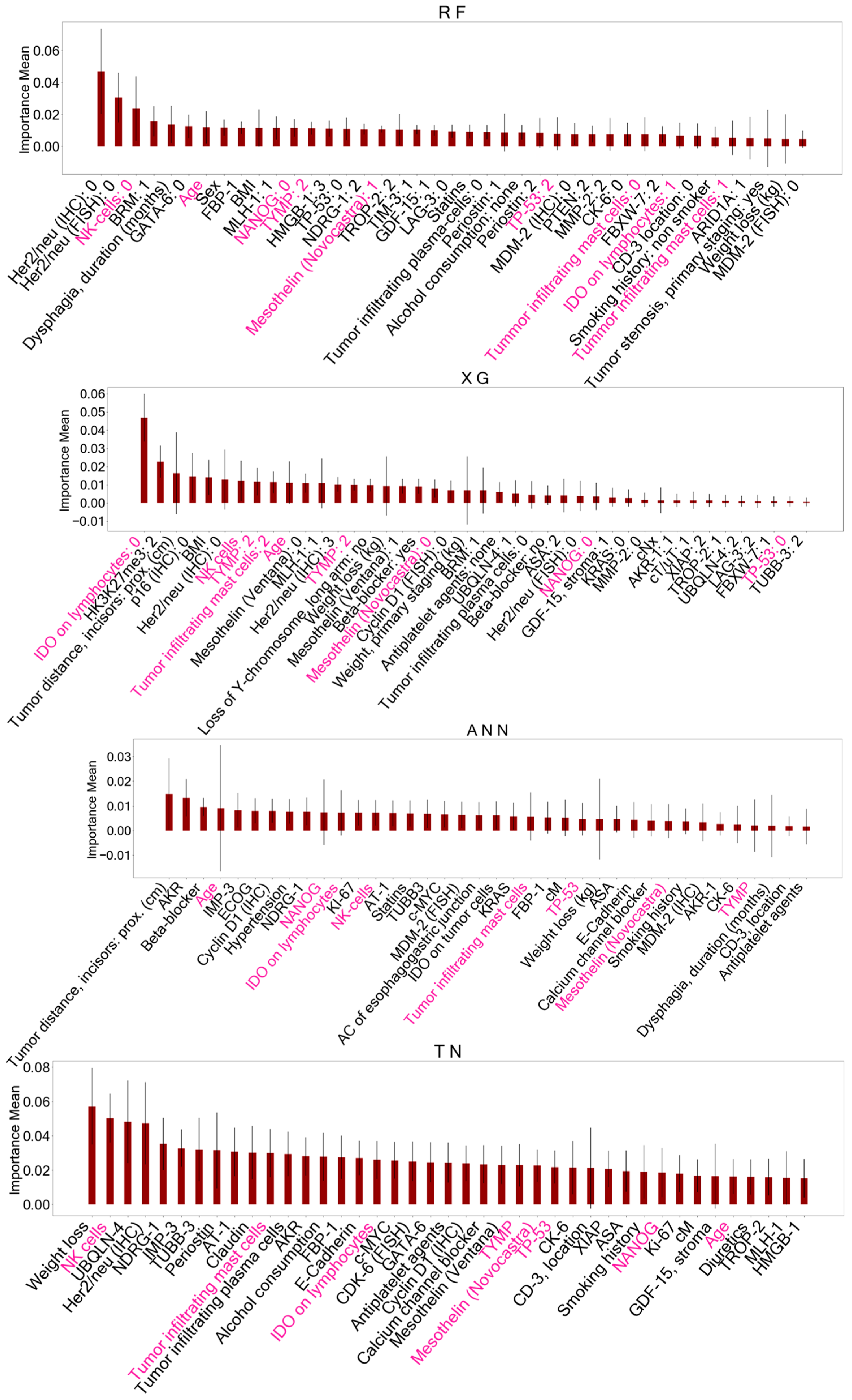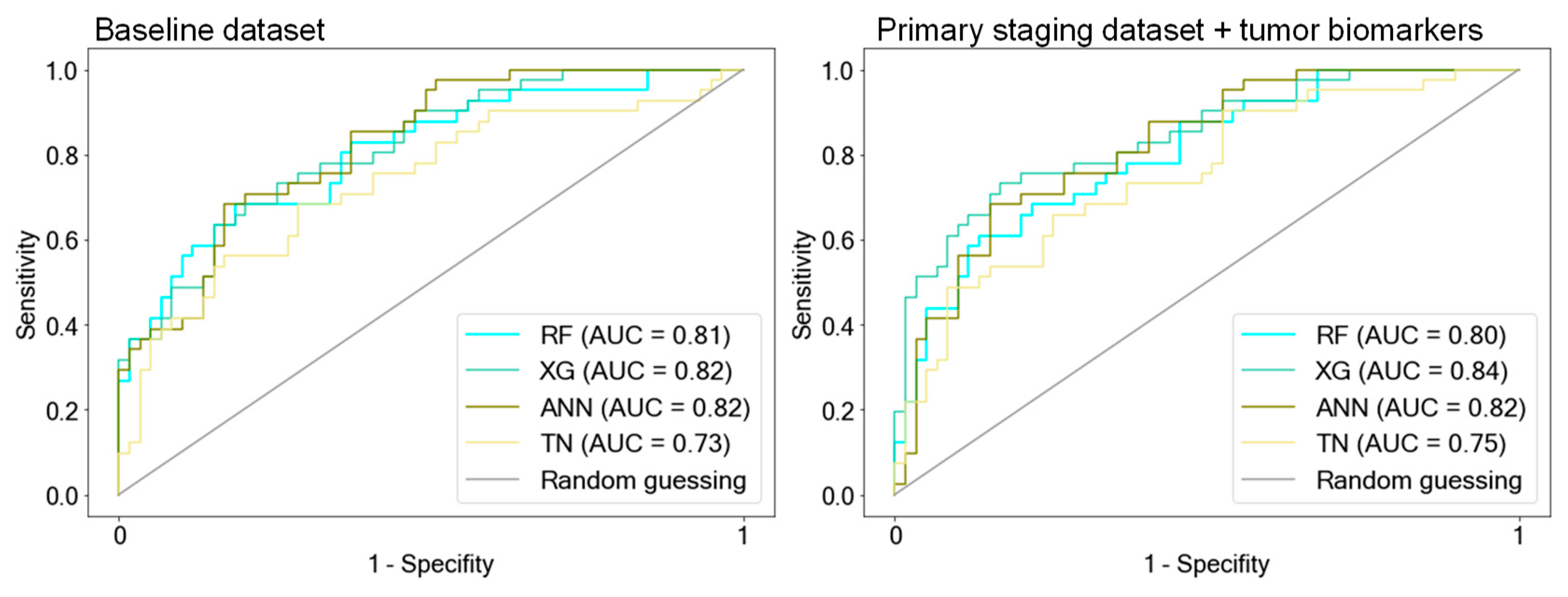Analyzing the Impact of Oncological Data at Different Time Points and Tumor Biomarkers on Artificial Intelligence Predictions for Five-Year Survival in Esophageal Cancer
Abstract
1. Introduction
2. Methods
2.1. Inclusion Criteria and Patient Characteristics
2.2. Models
2.3. Labeling, Data Splitting, and Data Preprocessing
2.4. Hyperparameter Search and Feature Selection via Permutation Feature Importance
2.5. Study Design
- We created three predefined data subsets from the training set for model training as follows:
- (a)
- Baseline dataset (BL): All clinical data, including information collected pre-, intra-, and postoperatively, as well as the pathological TNM status (n features = 55).
- (b)
- Two preoperative data subsets for model training to assess predictive performance as follows:
- -
- Primary staging dataset (PS dataset, n features = 29): This included only variables collected during primary staging until the time of the tumor board conference. It did not involve histopathological assessment.
- -
- PS dataset plus tumor biomarkers (PS dataset + biomarkers, n features = 84). As there was no histopathological assessment available from the initial tumor biopsy, biomarkers from the tumor sample after surgical treatment were used.
- We performed feature selection via PFI based on the BL dataset or the PS dataset with biomarkers. The important variables identified were used to create reduced datasets for model retraining (BL: n features = 23/26/27/28; PS + biomarkers: n features = 38/37/38/41 for RF/XG/ANN/TN, respectively).
- After model training on the distinct data subsets, predictions were always made on the independent test set.
2.6. Statistical Analysis
3. Results
3.1. AI Models Effectively Predict 5-Year Survival Using Clinical Data and Pathological TNM
3.2. Including Biomarkers into Early Clinical Data Demonstrates Similar Model Performance Compared to Comprehensive Clinical Data including the TNM Status
3.3. Models Trained on AI-Driven Data Subsets with Important Features Achieve Constant Predictive Performance
4. Discussion
5. Limitations
6. Conclusions
Supplementary Materials
Author Contributions
Funding
Data Availability Statement
Conflicts of Interest
References
- Topol, E.J. High-performance medicine: The convergence of human and artificial intelligence. Nat. Med. 2019, 25, 44–56. [Google Scholar] [CrossRef] [PubMed]
- Janiesch, C.; Zschech, P.; Heinrich, K. Machine learning and deep learning. Electron. Mark. 2021, 31, 685–695. [Google Scholar] [CrossRef]
- Gong, X.; Zheng, B.; Xu, G.; Chen, H.; Chen, C. Application of machine learning approaches to predict the 5-year survival status of patients with esophageal cancer. J. Thorac. Dis. 2021, 13, 6240–6251. [Google Scholar] [CrossRef] [PubMed]
- Jung, J.O.; Crnovrsanin, N.; Wirsik, N.M.; Nienhüser, H.; Peters, L.; Popp, F.; Schulze, A.; Wagner, M.; Müller-Stich, B.P.; Büchler, M.W.; et al. Machine learning for optimized individual survival prediction in resectable upper gastrointestinal cancer. J. Cancer Res. Clin. Oncol. 2022, 149, 1691–1702. [Google Scholar] [CrossRef]
- Sato, F.; Shimada, Y.; Selaru, F.M.; Shibata, D.; Maeda, M.; Watanabe, G.; Mori, Y.; Stass, S.A.; Imamura, M.; Meltzer, S.J. Prediction of survival in patients with esophageal carcinoma using artificial neural networks. Cancer 2005, 103, 1596–1605. [Google Scholar] [CrossRef]
- Alaskar, H.; Saba, T. Machine Learning and Deep Learning: A Comparative Review; Springer: Singapore, 2021. [Google Scholar] [CrossRef]
- Korteling, J.E.; van de Boer-Visschedijk, G.C.; Blankendaal, R.A.M.; Boonekamp, R.C.; Eikelboom, A.R. Human- versus Artificial Intelligence. Front. Artif. Intell. 2021, 4, 622364. [Google Scholar] [CrossRef]
- Bolger, J.C.; Donohoe, C.L.; Lowery, M.; Reynolds, J.V. Advances in the curative management of oesophageal cancer. Br. J. Cancer 2022, 126, 706–717. [Google Scholar] [CrossRef]
- Al-Batran, S.E.; Homann, N.; Pauligk, C.; Goetze, T.O.; Meiler, J.; Kasper, S.; Kopp, H.G.; Mayer, F.; Haag, G.M.; Luley, K.; et al. Perioperative chemotherapy with fluorouracil plus leucovorin, oxaliplatin, and docetaxel versus fluorouracil or capecitabine plus cisplatin and epirubicin for locally advanced, resectable gastric or gastro-oesophageal junction adenocarcinoma (FLOT4): A randomised, phase 2/3 trial. Lancet 2019, 393, 1948–1957. [Google Scholar] [CrossRef]
- Eyck, B.M.; Lanschot, J.J.B.v.; Hulshof, M.C.C.M.; Wilk, B.J.v.d.; Shapiro, J.; Hagen, P.v.; Henegouwen, M.I.v.B.; Wijnhoven, B.P.L.; Laarhoven, H.W.M.v.; Nieuwenhuijzen, G.A.P.; et al. Ten-Year Outcome of Neoadjuvant Chemoradiotherapy Plus Surgery for Esophageal Cancer: The Randomized Controlled CROSS Trial. J. Clin. Oncol. 2021, 39, 1995–2004. [Google Scholar] [CrossRef]
- Rice, T.W.; Patil, D.T.; Blackstone, E.H. 8th edition AJCC/UICC staging of cancers of the esophagus and esophagogastric junction: Application to clinical practice. Ann. Cardiothorac. Surg. 2017, 6, 119–130. [Google Scholar] [CrossRef]
- Robert Koch Institute; The Association of Population-Based Cancer Registries in Germany (Eds.) Cancer in Germany 2017/2018; Robert Koch Institute: Berlin, Germany, 2022; pp. 36–39. [Google Scholar]
- Siegel, R.L.; Miller, K.D.; Fuchs, H.E.; Jemal, A. Cancer statistics, 2022. CA A Cancer J. Clin. 2022, 72, 7–33. [Google Scholar] [CrossRef] [PubMed]
- Leitlinienprogramm Onkologie (Deutsche Krebsgesellschaft, D.K., AWMF). Diagnostik und Therapie der Plattenepithelkarzinome und Adenokarzinome des Ösophagus, Langversion 4.0. AWMF-Registernummer: 021-023OL 2023. Available online: https://www.leitlinienprogramm-onkologie.de/leitlinien/oesophaguskarzinom/ (accessed on 14 March 2024).
- Boniface, M.M.; Wani, S.B.; Schefter, T.E.; Koo, P.J.; Meguid, C.; Leong, S.; Kaplan, J.B.; Wingrove, L.J.; McCarter, M.D. Multidisciplinary management for esophageal and gastric cancer. Cancer Manag. Res. 2016, 8, 39–44. [Google Scholar] [CrossRef]
- Sun, J.-M.; Shen, L.; Shah, M.A.; Enzinger, P.; Adenis, A.; Doi, T.; Kojima, T.; Metges, J.-P.; Li, Z.; Kim, S.-B.; et al. Pembrolizumab plus chemotherapy versus chemotherapy alone for first-line treatment of advanced oesophageal cancer (KEYNOTE-590): A randomised, placebo-controlled, phase 3 study. Lancet 2021, 398, 759–771. [Google Scholar] [CrossRef]
- Shapiro, J.; van Lanschot, J.J.B.; Hulshof, M.; van Hagen, P.; van Berge Henegouwen, M.I.; Wijnhoven, B.P.L.; van Laarhoven, H.W.M.; Nieuwenhuijzen, G.A.P.; Hospers, G.A.P.; Bonenkamp, J.J.; et al. Neoadjuvant chemoradiotherapy plus surgery versus surgery alone for oesophageal or junctional cancer (CROSS): Long-term results of a randomised controlled trial. Lancet Oncol. 2015, 16, 1090–1098. [Google Scholar] [CrossRef] [PubMed]
- Damanakis, A.; Plum, P.S.; Gebauer, F.; Schröder, W.; Büttner, R.; Zander, T.; Bruns, C.J.; Quaas, A. Fructose-1,6-bisphosphatase 1 (FBP1) is an independent biomarker associated with a favorable prognosis in esophageal adenocarcinoma. J. Cancer Res. Clin. Oncol. 2022, 148, 2287–2293. [Google Scholar] [CrossRef] [PubMed]
- Essakly, A.; Loeser, H.; Kraemer, M.; Alakus, H.; Chon, S.H.; Zander, T.; Buettner, R.; Hillmer, A.M.; Bruns, C.J.; Schroeder, W.; et al. PIK3CA and KRAS Amplification in Esophageal Adenocarcinoma and their Impact on the Inflammatory Tumor Microenvironment and Prognosis. Transl. Oncol. 2020, 13, 157–164. [Google Scholar] [CrossRef]
- Gebauer, F.; Krämer, M.; Bruns, C.; Schlößer, H.A.; Thelen, M.; Lohneis, P.; Schröder, W.; Zander, T.; Alakus, H.; Buettner, R.; et al. Lymphocyte activation gene-3 (LAG3) mRNA and protein expression on tumour infiltrating lymphocytes (TILs) in oesophageal adenocarcinoma. J. Cancer Res. Clin. Oncol. 2020, 146, 2319–2327. [Google Scholar] [CrossRef] [PubMed]
- Hoppe, S.; Meder, L.; Gebauer, F.; Ullrich, R.T.; Zander, T.; Hillmer, A.M.; Buettner, R.; Plum, P.; Puppe, J.; Malter, W.; et al. Trophoblast Cell Surface Antigen 2 (TROP2) as a Predictive Bio-Marker for the Therapeutic Efficacy of Sacituzumab Govitecan in Adenocarcinoma of the Esophagus. Cancers 2022, 14, 4789. [Google Scholar] [CrossRef]
- Loeser, H.; Kraemer, M.; Gebauer, F.; Bruns, C.; Schröder, W.; Zander, T.; Alakus, H.; Hoelscher, A.; Buettner, R.; Lohneis, P.; et al. Indoleamine 2,3-Dioxygenase (IDO) Expression Is an Independent Prognostic Marker in Esophageal Adenocarcinoma. J. Immunol. Res. 2020, 2020, 2862647. [Google Scholar] [CrossRef]
- Loeser, H.; Schallenberg, S.; von Winterfeld, M.; Tharun, L.; Alakus, H.; Hölscher, A.; Bollschweiler, E.; Buettner, R.; Zander, T.; Quaas, A. High protein and mRNA expression levels of TUBB3 (class III ß-tubulin) are associated with aggressive tumor features in esophageal adenocarcinomas. Oncotarget 2017, 8, 115179–115189. [Google Scholar] [CrossRef][Green Version]
- Loeser, H.; Scholz, M.; Fuchs, H.; Essakly, A.; Damanakis, A.I.; Zander, T.; Büttner, R.; Schröder, W.; Bruns, C.; Quaas, A.; et al. Integrin alpha V (ITGAV) expression in esophageal adenocarcinoma is associated with shortened overall-survival. Sci. Rep. 2020, 10, 18411. [Google Scholar] [CrossRef] [PubMed]
- Loeser, H.; Wölwer, C.B.; Alakus, H.; Chon, S.H.; Zander, T.; Buettner, R.; Hillmer, A.M.; Bruns, C.J.; Schroeder, W.; Gebauer, F.; et al. Y Chromosome Loss is a Frequent Event in Barrett’s Adenocarcinoma and Associated with Poor Outcome. Cancers 2020, 12, 1743. [Google Scholar] [CrossRef] [PubMed]
- Moentenich, V.; Comut, E.; Gebauer, F.; Tuchscherer, A.; Bruns, C.; Schroeder, W.; Buettner, R.; Alakus, H.; Loeser, H.; Zander, T.; et al. Mesothelin expression in esophageal adenocarcinoma and squamous cell carcinoma and its possible impact on future treatment strategies. Ther. Adv. Med. Oncol. 2020, 12, 1758835920917571. [Google Scholar] [CrossRef]
- Moentenich, V.; Gebauer, F.; Comut, E.; Tuchscherer, A.; Bruns, C.; Schroeder, W.; Buettner, R.; Alakus, H.; Loeser, H.; Zander, T.; et al. Claudin 18.2 expression in esophageal adenocarcinoma and its potential impact on future treatment strategies. Oncol. Lett. 2020, 19, 3665–3670. [Google Scholar] [CrossRef]
- Plum, P.S.; Gebauer, F.; Krämer, M.; Alakus, H.; Berlth, F.; Chon, S.H.; Schiffmann, L.; Zander, T.; Büttner, R.; Hölscher, A.H.; et al. HER2/neu (ERBB2) expression and gene amplification correlates with better survival in esophageal adenocarcinoma. BMC Cancer 2019, 19, 38. [Google Scholar] [CrossRef]
- Plum, P.S.; Löser, H.; Zander, T.; Essakly, A.; Bruns, C.J.; Hillmer, A.M.; Alakus, H.; Schröder, W.; Büttner, R.; Gebauer, F.; et al. GATA binding protein 6 (GATA6) is co-amplified with PIK3CA in patients with esophageal adenocarcinoma and is linked to neoadjuvant therapy. J. Cancer Res. Clin. Oncol. 2021, 147, 1031–1040. [Google Scholar] [CrossRef]
- Plum, P.S.; Ulase, D.; Bollschweiler, E.; Chon, S.H.; Berlth, F.; Zander, T.; Alakus, H.; Hölscher, A.H.; Bruns, C.J.; Schallenberg, S.; et al. Upregulation of insulin-like growth factor II mRNA-binding protein 3 (IMP3) has negative prognostic impact on early invasive (pT1) adenocarcinoma of the esophagus. J. Cancer Res. Clin. Oncol. 2018, 144, 1731–1739. [Google Scholar] [CrossRef] [PubMed]
- Quaas, A.; Heydt, C.; Gebauer, F.; Alakus, H.; Loeser, H.; Buettner, R.; Hillmer, A.; Bruns, C.; Merkelbach-Bruse, S.; Zander, T.; et al. Genomic Characterization of TP53-Wild-Type Esophageal Carcinoma. Transl. Oncol. 2019, 12, 154–161. [Google Scholar] [CrossRef]
- Quaas, A.; Pamuk, A.; Klein, S.; Quantius, J.; Rehkaemper, J.; Barutcu, A.G.; Rueschoff, J.; Zander, T.; Gebauer, F.; Hillmer, A.; et al. Sex-specific prognostic effect of CD66b-positive tumor-infiltrating neutrophils (TANs) in gastric and esophageal adenocarcinoma. Gastric Cancer 2021, 24, 1213–1226. [Google Scholar] [CrossRef]
- Quaas, A.; Rehkaemper, J.; Rueschoff, J.; Pamuk, A.; Zander, T.; Hillmer, A.; Siemanowski, J.; Wittig, J.; Buettner, R.; Plum, P.; et al. Occurrence of High Microsatellite-Instability/Mismatch Repair Deficiency in Nearly 2,000 Human Adenocarcinomas of the Gastrointestinal Tract, Pancreas, and Bile Ducts: A Study From a Large German Comprehensive Cancer Center. Front. Oncol. 2021, 11, 569475. [Google Scholar] [CrossRef]
- Schallenberg, S.; Bork, J.; Essakly, A.; Alakus, H.; Buettner, R.; Hillmer, A.M.; Bruns, C.; Schroeder, W.; Zander, T.; Loeser, H.; et al. Loss of the SWI/SNF-ATPase subunit members SMARCF1 (ARID1A), SMARCA2 (BRM), SMARCA4 (BRG1) and SMARCB1 (INI1) in oesophageal adenocarcinoma. BMC Cancer 2020, 20, 12. [Google Scholar] [CrossRef]
- Schiffmann, L.M.; Göbel, H.; Löser, H.; Schorn, F.; Werthenbach, J.P.; Fuchs, H.F.; Plum, P.S.; Bludau, M.; Zander, T.; Schröder, W.; et al. Elevated X-linked inhibitor of apoptosis protein (XIAP) expression uncovers detrimental prognosis in subgroups of neoadjuvant treated and T-cell rich esophageal adenocarcinoma. BMC Cancer 2019, 19, 531. [Google Scholar] [CrossRef]
- Schoemig-Markiefka, B.; Eschbach, J.; Scheel, A.H.; Pamuk, A.; Rueschoff, J.; Zander, T.; Buettner, R.; Schroeder, W.; Bruns, C.J.; Loeser, H.; et al. Optimized PD-L1 scoring of gastric cancer. Gastric Cancer 2021, 24, 1115–1122. [Google Scholar] [CrossRef] [PubMed]
- Schoemmel, M.; Loeser, H.; Kraemer, M.; Wagener-Ryczek, S.; Hillmer, A.; Bruns, C.; Thelen, M.; Schröder, W.; Zander, T.; Lechner, A.; et al. Distribution of tumor-infiltrating-T-lymphocytes and possible tumor-escape mechanisms avoiding immune cell attack in locally advanced adenocarcinomas of the esophagus. Clin. Transl. Oncol. 2021, 23, 1601–1610. [Google Scholar] [CrossRef] [PubMed]
- Pedregosa, F.; Varoquaux, G.; Gramfort, A.; Michel, V.; Thirion, B.; Grisel, O.; Blondel, M.; Prettenhofer, P.; Weiss, R.; Dubourg, V. Scikit-learn: Machine Learning in Python. J. Mach. Learn. Res. 2011, 12, 2825–2830. [Google Scholar] [CrossRef]
- Breiman, L. Random forests. Mach. Learn. 2001, 45, 5–32. [Google Scholar] [CrossRef]
- Biau, G. Analysis of a random forests model. J. Mach. Learn. Res. 2012, 13, 1063–1095. [Google Scholar] [CrossRef]
- Chen, T.; Guestrin, C. XGBoost: A Scalable Tree Boosting System. In Proceedings of the 22nd ACM SIGKDD International Conference on Knowledge Discovery and Data Mining, San Francisco, CA, USA, 13–17 August 2016; pp. 785–794. [Google Scholar] [CrossRef]
- Walczak, S.; Cerpa, N. Artificial Neural Networks. In Encyclopedia of Physical Science and Technology, 3rd ed.; Meyers, R.A., Ed.; Academic Press: New York, NY, USA, 2003; pp. 631–645. [Google Scholar] [CrossRef]
- Howard, J.; Gugger, S. Fastai: A Layered API for Deep Dearning. Information 2020, 11, 108. [Google Scholar] [CrossRef]
- Arik, S.Ö.; Pfister, T. TabNet: Attentive Interpretable Tabular Learning. In Proceedings of the AAAI Conference on Artificial Intelligence, Online, 2–9 February 2021. [Google Scholar] [CrossRef]
- Dreamquark. Pytorch_Tabnet. 2019. Available online: https://dreamquark-ai.github.io/tabnet/index.html (accessed on 21 October 2022).
- Kleinbaum, D.G. Introduction to Logistic Regression. In Logistic Regression: A Self-Learning Text; Springer: New York, NY, USA, 1994; pp. 1–38. [Google Scholar] [CrossRef]
- Akiba, T.; Sano, S.; Yanase, T.; Ohta, T.; Koyama, M. Optuna: A next-generation hyperparameter optimization framework. In Proceedings of the 25th ACM SIGKDD International Conference on Knowledge Discovery & Data Mining, Anchorage, AK, USA, 4–8 August 2019. [Google Scholar] [CrossRef]
- Altmann, A.; Toloşi, L.; Sander, O.; Lengauer, T. Permutation importance: A corrected feature importance measure. Bioinformatics 2010, 26, 1340–1347. [Google Scholar] [CrossRef] [PubMed]
- Mueller, Z. Walkwithfastai. 2020. Available online: https://walkwithfastai.com/Regression_and_Permutation_Importance (accessed on 3 November 2022).
- McKinney, W. Data structures for statistical computing in python. In Proceedings of the 9th Python in Science Conference, Austin, TX, USA, 28–30 June 2010. [Google Scholar]
- Harris, C.R.; Millman, K.J.; Van Der Walt, S.J.; Gommers, R.; Virtanen, P.; Cournapeau, D.; Wieser, E.; Taylor, J.; Berg, S.; Smith, N.J. Array programming with NumPy. Nature 2020, 585, 357–362. [Google Scholar] [CrossRef]
- Hunter, J.D. Matplotlib: A 2D graphics environment. Comput. Sci. Eng. 2007, 9, 90–95. [Google Scholar] [CrossRef]
- Donders, A.R.T.; van der Heijden, G.J.M.G.; Stijnen, T.; Moons, K.G.M. Review: A gentle introduction to imputation of missing values. J. Clin. Epidemiol. 2006, 59, 1087–1091. [Google Scholar] [CrossRef] [PubMed]
- Hashimoto, D.A.; Rosman, G.; Rus, D.; Meireles, O.R. Artificial Intelligence in Surgery: Promises and Perils. Ann. Surg. 2018, 268, 70–76. [Google Scholar] [CrossRef] [PubMed]
- Visaggi, P.; Barberio, B.; Gregori, D.; Azzolina, D.; Martinato, M.; Hassan, C.; Sharma, P.; Savarino, E.; de Bortoli, N. Systematic review with meta-analysis: Artificial intelligence in the diagnosis of oesophageal diseases. Aliment. Pharmacol. Ther. 2022, 55, 528–540. [Google Scholar] [CrossRef] [PubMed]
- Bzdok, D.; Altman, N.; Krzywinski, M. Statistics versus machine learning. Nat. Methods 2018, 15, 233–234. [Google Scholar] [CrossRef] [PubMed]
- Rahman, S.A.; Walker, R.C.; Maynard, N.; Trudgill, N.; Crosby, T.; Cromwell, D.A.; Underwood, T.J. The AUGIS Survival Predictor: Prediction of Long-term and Conditional Survival after Esophagectomy Using Random Survival Forests. Ann. Surg. 2021, 277, 267–274. [Google Scholar] [CrossRef]
- Molnar, C.; König, G.; Herbinger, J.; Freiesleben, T.; Dandl, S.; Scholbeck, C.A.; Casalicchio, G.; Grosse-Wentrup, M.; Bischl, B. General pitfalls of model-agnostic interpretation methods for machine learning models. In International Workshop on Extending Explainable AI beyond Deep Models and Classifiers; Springer: Berlin/Heidelberg, Germany, 2020. [Google Scholar] [CrossRef]
- Hosch, S.B.; Stoecklein, N.H.; Pichlmeier, U.; Rehders, A.; Scheunemann, P.; Niendorf, A.; Knoefel, W.T.; Izbicki, J.R. Esophageal cancer: The mode of lymphatic tumor cell spread and its prognostic significance. J. Clin. Oncol. 2001, 19, 1970–1975. [Google Scholar] [CrossRef]
- Mariette, C.; Piessen, G.; Briez, N.; Triboulet, J.P. The number of metastatic lymph nodes and the ratio between metastatic and examined lymph nodes are independent prognostic factors in esophageal cancer regardless of neoadjuvant chemoradiation or lymphadenectomy extent. Ann. Surg. 2008, 247, 365–371. [Google Scholar] [CrossRef]
- Swanson, S.J.; Batirel, H.F.; Bueno, R.; Jaklitsch, M.T.; Lukanich, J.M.; Allred, E.; Mentzer, S.J.; Sugarbaker, D.J. Transthoracic esophagectomy with radical mediastinal and abdominal lymph node dissection and cervical esophagogastrostomy for esophageal carcinoma. Ann. Thorac. Surg. 2001, 72, 1918–1924; discussion 1924–1915. [Google Scholar] [CrossRef]
- Damanakis, A.I.; Gebauer, F.; Stapper, A.; Schlößer, H.A.; Ghadimi, M.; Schmidt, T.; Schiffmann, L.M.; Fuchs, H.; Zander, T.; Quaas, A.; et al. Combined regression score predicts outcome after neoadjuvant treatment of oesophageal cancer. Br. J. Cancer 2023, 128, 2025–2035. [Google Scholar] [CrossRef]
- Narusaka, T.; Ohara, T.; Noma, K.; Nishiwaki, N.; Katsura, Y.; Kato, T.; Sato, H.; Tomono, Y.; Kikuchi, S.; Tazawa, H.; et al. Nanog is a promising chemoresistant stemness marker and therapeutic target by iron chelators for esophageal cancer. Int. J. Cancer 2021, 149, 347–357. [Google Scholar] [CrossRef] [PubMed]
- Shimada, H.; Takeda, A.; Shiratori, T.; Nabeya, Y.; Okazumi, S.-i.; Matsubara, H.; Funami, Y.; Hayashi, H.; Gunji, Y.; Kobayashi, S.; et al. Prognostic significance of serum thymidine phosphorylase concentration in esophageal squamous cell carcinoma. Cancer 2002, 94, 1947–1954. [Google Scholar] [CrossRef]
- Lv, L.; Pan, K.; Li, X.D.; She, K.L.; Zhao, J.J.; Wang, W.; Chen, J.G.; Chen, Y.B.; Yun, J.P.; Xia, J.C. The accumulation and prognosis value of tumor infiltrating IL-17 producing cells in esophageal squamous cell carcinoma. PLoS ONE 2011, 6, e18219. [Google Scholar] [CrossRef]
- Elpek, G.O.; Gelen, T.; Aksoy, N.H.; Erdoğan, A.; Dertsiz, L.; Demircan, A.; Keleş, N. The prognostic relevance of angiogenesis and mast cells in squamous cell carcinoma of the oesophagus. J. Clin. Pathol. 2001, 54, 940–944. [Google Scholar] [CrossRef] [PubMed]
- Fakhrjou, A.; Niroumand-Oscoei, S.M.; Somi, M.H.; Ghojazadeh, M.; Naghashi, S.; Samankan, S. Prognostic value of tumor-infiltrating mast cells in outcome of patients with esophagus squamous cell carcinoma. J. Gastrointest. Cancer 2014, 45, 48–53. [Google Scholar] [CrossRef] [PubMed]





| No. | % | ||
|---|---|---|---|
| Total patients (N) | 1002 | ||
| CLINICAL CHARACTERISTICS | |||
| Age at surgical treatment | mean ± SD (y) | 62.2 ± 10.1 | |
| Sex assigned at birth | |||
| Female | 157 | 15.7 | |
| Male | 845 | 84.3 | |
| MEDICAL TREATMENT | |||
| Neoadjuvant therapy | yes/no | 692/263 | 69.1/26.2 |
| Type of neoadjuvant therapy | |||
| CROSS protocol [17] | 401 | 40.02 | |
| FLOT protocol [9] | 109 | 10.9 | |
| other | 204 | 20.4 | |
| TUMOR-ASSOCIATED FACTORS | |||
| Histology | |||
| ACC | 842 | 84.03 | |
| SCC | 147 | 14.7 | |
| other | 12 | 1.2 | |
| pT | |||
| 0 | 135 | 13.5 | |
| 1a/1b | 248 | 24.8 | |
| 2 | 157 | 15.7 | |
| 3 | 440 | 43.9 | |
| 4a/b | 17 | 1.7 | |
| Tis | 1 | 0.1 | |
| pN | |||
| 0 | 513 | 511.9 | |
| 1 | 250 | 24.9 | |
| 2 | 135 | 13.5 | |
| 3 | 100 | 9.9 | |
| pL | |||
| 0 | 600 | 59.9 | |
| 1 | 226 | 22.6 | |
| pV | |||
| 0 | 762 | 76.04 | |
| 1 | 59 | 5.9 | |
| Total resected lymph nodes | mean ± SD (n) | 30.8 ± 11.3 | |
| Positive lymph nodes | mean ± SD (n) | 2.3 ± 4.7 | |
| BL | PS | PS + BIOMARKERS | ||
|---|---|---|---|---|
| RF | ACC 95%-CI | 0.73 [0.64, 0.82] | 0.70 [0.61, 0.79] | 0.77 [0.69, 0.85] |
| AUC | 0.78 | 0.77 | 0.83 | |
| CV-score ± SD | 0.78 ± 0.04 | 0.65 ± 0.03 | 0.68 ± 0.04 | |
| XG | ACC 95%-CI | 0.74 [0.65, 0.83] | 0.73 [0.64, 0.82] | 0.79 [0.71, 0.87] |
| AUC | 0.82 | 0.80 | 0.85 | |
| CV-score ± SD | 0.77 ± 0.04 | 0.67 ± 0.05 | 0.69 ± 0.04 | |
| ANN | ACC 95%-CI | 0. 76 [0.68, 0.84] | 0.71 [0.62, 0.80] | 0.75 [0.67, 0.83] |
| AUC | 0.83 | 0.76 | 0.86 | |
| CV-score ± SD | 0.73 ± 0.02 | 0.71 ± 0.02 | 0.76 ± 0.03 | |
| TN | ACC 95%-CI | 0.75 [0.67, 0.83] | 0.69 [0.60, 0.78] | 0.72 [0.63, 0.80] |
| AUC | 0.80 | 0.70 | 0.76 | |
| CV-score ± SD | 0.66 ± 0.03 | 0.64 ± 0.03 | 0.69 ± 0.04 | |
| LR | ACC 95%-CI | 0.73 [0.64, 0.82] | 0.63 [0.54, 0.72] | 0.66 [0.57, 0.75] |
| AUC | 0.79 | 0.70 | 0.69 | |
| CV-score ± SD | 0.73 ± 0.05 | 0.65 ± 0.05 | 0.60 ± 0.04 | |
| AI-DRIVEN DATA SUBSETS | BL | PS + BIOMARKERS | |
|---|---|---|---|
| RF | ACC 95%-CI | 0.76 [0.68, 0.84] | 0.76 [0.68, 0.84] |
| AUC | 0.81 | 0.80 | |
| CV-score ± SD | 0.77 ± 0.05 | 0.70 ± 0.05 | |
| XG | ACC 95%-CI | 0.72 [0.63, 0.81] | 0.78 [0.70, 0.86] |
| AUC | 0.82 | 0.84 | |
| CV-score ± SD | 0.77 ± 0.05 | 0.70 ± 0.04 | |
| ANN | ACC 95%-CI | 0.77 [0.69, 0.85] | 0.76 [0.68, 0.84] |
| AUC | 0.82 | 0.82 | |
| CV-score ± SD | 0.75 ± 0.01 | 0.73 ± 0.04 | |
| TN | ACC 95%-CI | 0.70 [0.60, 0.78] | 0.74 [0.65, 0.83] |
| AUC | 0.73 | 0.75 | |
| CV-score ± SD | 0.68 ± 0.03 | 0.7 ± 0.05 | |
Disclaimer/Publisher’s Note: The statements, opinions and data contained in all publications are solely those of the individual author(s) and contributor(s) and not of MDPI and/or the editor(s). MDPI and/or the editor(s) disclaim responsibility for any injury to people or property resulting from any ideas, methods, instructions or products referred to in the content. |
© 2024 by the authors. Licensee MDPI, Basel, Switzerland. This article is an open access article distributed under the terms and conditions of the Creative Commons Attribution (CC BY) license (https://creativecommons.org/licenses/by/4.0/).
Share and Cite
Lukomski, L.; Pisula, J.; Wirsik, N.; Damanakis, A.; Jung, J.-O.; Knipper, K.; Datta, R.; Schröder, W.; Gebauer, F.; Schmidt, T.; et al. Analyzing the Impact of Oncological Data at Different Time Points and Tumor Biomarkers on Artificial Intelligence Predictions for Five-Year Survival in Esophageal Cancer. Mach. Learn. Knowl. Extr. 2024, 6, 679-698. https://doi.org/10.3390/make6010032
Lukomski L, Pisula J, Wirsik N, Damanakis A, Jung J-O, Knipper K, Datta R, Schröder W, Gebauer F, Schmidt T, et al. Analyzing the Impact of Oncological Data at Different Time Points and Tumor Biomarkers on Artificial Intelligence Predictions for Five-Year Survival in Esophageal Cancer. Machine Learning and Knowledge Extraction. 2024; 6(1):679-698. https://doi.org/10.3390/make6010032
Chicago/Turabian StyleLukomski, Leandra, Juan Pisula, Naita Wirsik, Alexander Damanakis, Jin-On Jung, Karl Knipper, Rabi Datta, Wolfgang Schröder, Florian Gebauer, Thomas Schmidt, and et al. 2024. "Analyzing the Impact of Oncological Data at Different Time Points and Tumor Biomarkers on Artificial Intelligence Predictions for Five-Year Survival in Esophageal Cancer" Machine Learning and Knowledge Extraction 6, no. 1: 679-698. https://doi.org/10.3390/make6010032
APA StyleLukomski, L., Pisula, J., Wirsik, N., Damanakis, A., Jung, J.-O., Knipper, K., Datta, R., Schröder, W., Gebauer, F., Schmidt, T., Quaas, A., Bozek, K., Bruns, C., & Popp, F. (2024). Analyzing the Impact of Oncological Data at Different Time Points and Tumor Biomarkers on Artificial Intelligence Predictions for Five-Year Survival in Esophageal Cancer. Machine Learning and Knowledge Extraction, 6(1), 679-698. https://doi.org/10.3390/make6010032






